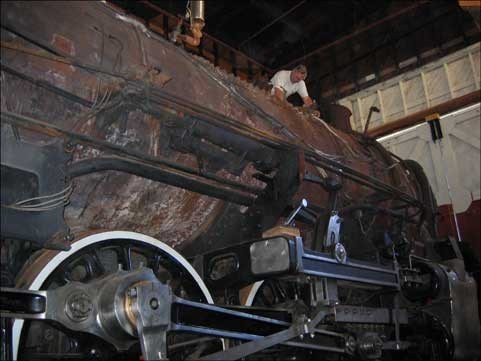"I think she’s just as beautiful with her clothes off," Singh Biln says.
The former B.C. Rail executive and confessed train buff is talking about the Royal Hudson, the 1940 steam engine that ran for 25 years between Vancouver and Squamish. Now stripped to her bare essentials at a West Coast Railway Association maintenance shed in Squamish, the locomotive has been undergoing a $500,000 renovation for the past year.
Singh, now the association’s major projects manager, said the Royal Hudson could be steaming from North Vancouver to Squamish or Whistler six-10 times per year starting September.
But at the moment a team of a dozen volunteers and paid contractors are working seven days a week to rebuild the engine’s boiler in preparation for a hydrostatic test and provincial certification that will allow the engine to go back in service.
On one of the hottest days this year boilermaker Randy Guzz is inside the 10-foot wide firebox, welding in the last of 260 custom milled 20-ft. long boiler tubings. The son of a boilermaker, Biln said Guzz is one of the few boilermakers left in Canada who understands steam locomotives. Built to flex and adjust to train movement, steam locomotives with their many moving parts are more prone to leaking than conventional diesel locomotives that replaced them in the mid-1950s.
Built in Montreal, the Royal Hudson 2860 was a sister locomotive to the 2850 that carried their royal highnesses, King George VI and his wife, Queen Elizabeth on their 1939 cross-Canada royal tour. With a 14-wheel configuration that includes eight pony wheels and six 75-inch driving wheels, the Royal Hudson 2860 had a top speed of 120 miles per hour on the run she was originally designed for, from Vancouver to Revelstoke. In service for 16 years before her first retirement, the locomotive was rescued in the 1960s and put back into service in 1974 by the Royal Hudson Steam Society. Facing a $2.5 million boiler replacement in 1999 she was again retired. But now with $400,000 in grants from provincial and federal governments and numerous private donations the locomotive is undergoing a boiler upgrade, which means she can not run on a daily basis but will be able to make several excursions a year.
"Not too far from home," said Biln, an electrical engineer who worked on the 1999 report that detailed the locomotive’s upgrading requirements. By limiting the amount of runs she makes Biln is hoping the boiler upgrades rather than replacements will keep the Royal Hudson running another 10-15 years.
The year-long project, led and documented by steam fitter Trevor Mills, has been complicated, requiring custom milling of parts from as far as Pittsburgh and hand placing 800 stay-bolts, 835 flex caps and 260 tubes and flues. Volunteers have removed rust and re-painted the engine with high temperature immersion black paint. Stripped of running boards, insulation, coverings, and front nose, the Hudson is still an impressive locomotive as casing caps are torqued down in preparation for hydrostatic testing. A shiny dynamo on top of the engine that generates electricity to light the coach cars it pulled attests to its forward-thinking original design. Brass-buttoned original leather arm rests outside the engineer windows are dusty but uncracked.
Although Biln has worked around trains since he graduated from the University of British Columbia in 1976, the former B.C. Rail chief mechanical officer said he has never worked this closely on a project. "It was done by people in my department and I knew about projects but I’ve never worked this hands-on before."
A man who admits he still has toy trains he played with as a child, he is careful to thank each worker as they pack up tools at end of day. Biln said if the locomotive springs leaks in any of the thousands of possible places during the hydrostatic test he is confident staff will quickly put it right.
"I don’t think we’ll run into anything major because we have people who know what they’re doing."
He anticipates it will take all of July to fully "clothe" the Hudson before firing her up in August for an anticipated first run in September. Noting the park had 50,000 visitors last summer with more than 600 paying to take one demonstration train 1,500 feet, he thinks space on the Royal Hudson, which may run with Rocky Mountaineer Vacation’s Whistler Mountaineer or with its own coaches, should prove to be a hot commodity.




